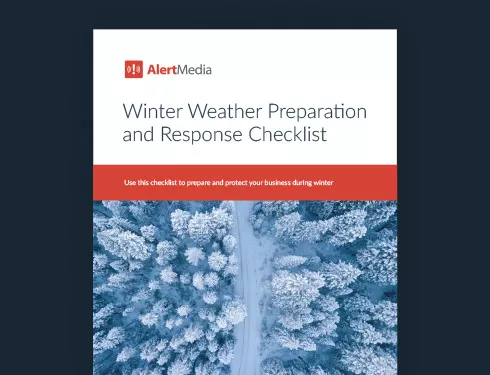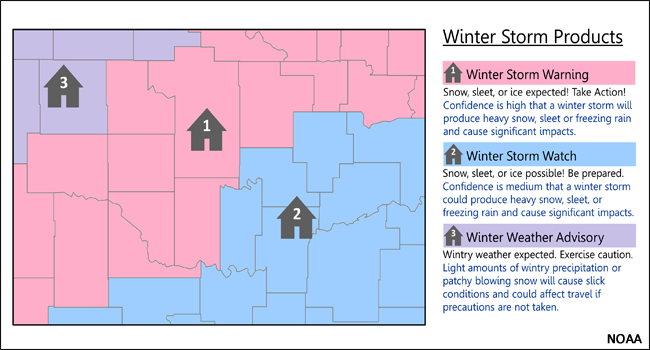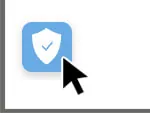
Winter Preparedness Checklist for Business
Don’t let your holiday plans and end-of-year goals distract you from the approaching threats of winter weather. Complete all the items on your winter preparedness checklist so you can rest easy knowing your team is ready for whatever storms are on the horizon.

When winter storm Uri hit Central Texas in 2021 with unprecedented snowfall, damaging ice, and failing infrastructure, resulting in no power or running water for days, businesses faced significant challenges. One of those businesses is Austin Pets Alive! (APA), a no-kill shelter out of Austin. They had a staff of more than 200 employees and a major network of volunteers to consider, and they had the animals stranded in their facilities. This severe storm posed a dangerous threat that could be mitigated only with the right preparation ahead of time.
See how Austin Pets Alive! navigates emergency situations with so many lives hanging in the balance.
The impact of winter storm Uri is a perfect example of why all companies need to consider winter storm preparations, not just those in the typical path of epic nor’easters. The prolonged record-cold temperatures in February 2021 left nearly 10 million people without power across the U.S. The storm’s impact in Texas highlights how severe weather events can defy our expectations based on how regions have historically been impacted. And these record- and expectation-breaking events are happening more often. In the current threat climate, being prepared also means preparing for the unexpected.
While the characteristics of winter weather vary by location, every business faces changing threats as winter approaches. Snow, rain, plummeting temperatures, illness outbreaks, dangerous driving conditions, and increased fire dangers are just a few of the threats that may impact your people and business this winter.
Emergency preparedness is key to mitigating potential disruptions, whether your organization is a small business or a large-scale enterprise. You want to check off all your preparation tasks long before the forecast calls for snow, and you can simplify this process with a winter preparedness checklist—which you can download for free here.
2023–2024 Winter Weather Predictions
This year, NOAA is predicting El Niño conditions for the 2023–2024 winter months—meaning above-average temperatures in the North and wetter-than-average conditions in the South, improving drought conditions. Many businesses will need to change up their winter weather preparations to account for this shift, as this year’s forecast breaks a pattern that has formed with the last several years of La Niña conditions.
Winter Weather Checklist
Steps in Your Winter Preparedness Checklist
From physical winter storm preparations to ensuring employees have access to all the information they need during a winter event, here are six steps to protect your business all season long.
Winter Preparedness Checklist | ||
1. Assess your risks
There are several hazards of winter weather that businesses need to consider. It’s not just icy roads and snow accumulation. A few of the cold-weather risks businesses face are an increased likelihood of structural stress and damage, dangerous fire activity, and slip and fall injuries.
The first step in your winter preparedness checklist is assessing your organization’s risks. You must consider where your employees live (including those who are distant and working remotely), where your offices are located, what industry you operate in—even how your employees work. All of these factors will inform your threat assessment and prioritization of preparedness plans.
Winter weather threats
Here are just a few potential winter hazards to consider as you evaluate your specific risks:
- COVID-19, flu, and other seasonal illnesses
- Unsafe driving conditions
- Road closures
- Slip and fall injuries
- Hypothermia and frostbite
- Flight delays and cancellations
- Local school delays and closures
- Structural stress and damage
- Electrical fires and other hazards
- Power/systems outages (both in the workplace and for employees working remotely)
A winter storm warning is typically issued 12–36 hours before a winter event is expected to start, so vigilantly checking local news and following travel safety recommendations can help you stay on top of regional threats. But the reality is, that’s only half the battle.
What about traveling or field-based employees? Or offices in other cities? The rise in remote work also presents unique safety and preparedness challenges. With an increasingly dispersed workforce, it’s not enough to track winter weather threats in one locale—you need to track the myriad of threats that could impact any of your employees, no matter where they are located.
2. Determine who’s responsible
Who should ensure the office parking lot is safe and drivable when a snowstorm hits? Who will track the storm and communicate weather-related updates to employees? There is a better time to figure out who is responsible for these tasks than in the midst of a storm.
Your organization is accountable for your employees’ overall safety and well-being. To fulfill your organization’s duty of care, you must take all necessary safety precautions—regardless of whether those measures are executed by your organization or a third party. Review your contracts with vendors, insurance providers, property managers, and landlords as part of your winter storm preparations. There should be specific callouts for weather-related events. If not, contact the contract owners directly to determine contractual obligations and responsibilities.
Aside from outlining the responsibilities of all external parties, it’s equally important to take a similar approach internally. You should have processes and responsible parties laid out for internal functions such as keeping employees informed of rapidly developing situations, ensuring all employees are accounted for, and keeping facilities and equipment in safe operating condition.
For example, you may want one person specifically dedicated to keeping an eye on winter weather forecasts. In a recent episode of The Employee Safety Podcast, AlertMedia’s Senior Meteorologist, Jason Moreland, explained, “With winter weather, it can be incredibly difficult to forecast, even compared to some of those other hazards like tornado events and hurricanes. In fact, we can often see major forecast adjustments leading up to and even during major winter storm events… It’s going to be really important to have at least one person within each company closely watching the forecast as it impacts all of their staff.”
Assemble a project team of involved stakeholders to outline each function’s roles and responsibilities clearly. This team should include HR, facilities, business continuity, emergency operations, and IT departments. A clear, documented plan of who will do what during a winter storm is critical in a small business where functions often overlap. It will help avoid confusion, finger-pointing, and missteps when a safe response matters most.
3. Make a plan for each winter storm threat
Once you’ve identified your risks and determined who is responsible for completing each precautionary measure, create a specific action plan for each winter storm hazard you may encounter to eliminate ambiguity and keep everyone on the same page.
Sign up for relevant winter weather advisories and winter storm warnings. Outline clear triggers for when and how you will make important decisions, like when to close the office or tell employees to leave work early. You should also put together specific plans for different threats from severe winter weather, like extreme cold temperatures, freezing rain, heavy snow, carbon monoxide poisoning, and even blizzard warnings. You should also train your managers and employees on how to keep an eye out for signs of hypothermia, frostbite, and other health threats like overexertion and heart attacks.
You can develop a winter storm preparation checklist that specifically lays out each necessary step from the moment the storm warning hits all the way through the recovery period. Include preparation items like filling gas tanks, dripping faucets, and buying extra supplies.
And remember that you should not be preparing for extreme weather conditions in a vacuum. It’s great to have a plan—but even the best-laid plans fall short if your business leaders and employees aren’t also prepared. At a minimum, rehearse various winter weather scenarios in drills with key leaders and people managers, and train employees in cold-weather safety.
4. Fortify your locations against extreme cold
Winterizing your business requires comprehensive planning and meticulous attention to detail. Don’t wait until a storm is announced to fortify your facilities to withstand winter threats and hazards. As part of your winter storm preparations, be sure to conduct regular inspections and maintenance of your offices, supplies, and equipment. You should check carbon monoxide detectors, elevators, and evacuation routes. These early inspections also allow you to identify any materials necessary for maintenance—well before the storm is at your doorstep.
Here are a few winter storm preparations and precautions that can be made well in advance of a winter storm warning to protect your facilities:
- Maintain all roofs, and keep current with repairs
- Check attics and weather stripping for leaks and add caulk to gaps in insulation
- Add pipe insulation to protect plumbing and prevent frozen pipes
- Test your heaters, thermostats, and lighting systems
- Ensure all smoke and carbon monoxide detectors are in working order
- Check fuel lines and refill all necessary propane tanks as necessary
- Develop a power outage backup plan
How businesses can prepare for winter storm power outages
One of the primary concerns during a winter storm is the loss of power. Winter storms often knock out power lines, and power outages and power surges can be disastrous for your people and business, especially if you don’t have a power outage emergency response plan. Losing power can hamper employee productivity, threaten employee safety, and impede vital business operations. And a power surge can lead to devastating data loss if employees’ work isn’t automatically backed up.
While a power outage can be dangerous, there are a few winter storm preparations you can take to ensure your staff, space, and systems are ready for a power outage.
Before the storm hits, consider taking these preventative measures:
- Keep a variety of portable chargers and battery banks on hand and charged
- Install emergency lighting throughout the building, including all exit routes
- Train employees on how to keep safe during a power outage
- Get power surge protectors to protect expensive computer equipment
- Invest in a backup generator
- Implement a secure data backup solution to prevent data loss
- Have a plan for communicating with employees across multiple channels (text, email, phone)
5. Equip your people
In addition to preparing your facilities for winter, you’ll also need to prepare your employees and ensure they have the equipment and resources they need to stay safe.
Share winter safety tips, whether employees are working from home or in the office. Review space heater and backup generator safety procedures. Ensure employees working outdoors have adequate protective clothing and know how to recognize the warning signs of frostbite and hypothermia (e.g., lighter-than-normal skin on fingers, toes, cheeks, or earlobes). Service any company vehicles before the winter season to ensure the battery, tire tread, windshield wipers, and antifreeze levels are satisfactory. You’ll also want to be sure employees have access to emergency supplies at home, at work, and while driving.
Lean on weather-related threat intelligence
One of the most important aspects of winter weather preparedness is being informed and taking action as soon as it becomes apparent a weather event is going to impact your people. Fortunately, the National Weather Service provides ongoing, real-time information about weather events as they occur. You should know—and keep an eye out for—the three NWS severity distinctions for winter weather events. Remembering that these labels indicate a storm’s likelihood rather than the potential severity is helpful.
- Winter Weather Advisories are the least severe weather designation and suggest light wintery precipitation is expected, which could create slick conditions and impact travel. When you get an advisory, you should check that you have the necessary preparations and supplies in case the forecast increases to a watch or warning.
- A Winter Storm Watch is the National Weather Service’s designation for storms anticipated to produce heavier precipitation resulting in snow, sleet, or ice. When you get a winter storm watch, you will want to alert your employees and prepare your facility for a storm.
- A Winter Storm Warning is the highest severity designation and means there is a high level of certainty that a storm will produce snow, sleet, or ice. If you get a winter storm warning, your preparations should already be underway or completed. Often, the storm may already have started or will happen soon.

Equipped with a modern threat intelligence solution, your organization can further bolster preparedness by leveraging real-time weather data in conjunction with location data and other sources to assess and predict the impact of weather events before they occur.
Stock up on winter safety essentials
When a severe winter storm hits, your people should be prepared to shelter in place for at least 72 hours. This means all employees should have access to an emergency supply kit at home and work with adequate provisions for three days.
“You want to stock up on those supplies, whether it be de-icing salt, sand, heaters, generators, or other things that could be in short supply once the forecast turns more unfavorable. I know that we’re still dealing with some logistics issues when it comes to inventories around the country… As soon as the forecast makes a turn for the worse, a lot of those more common preparation items are going to be in short supply.”
—Jason Moreland, Senior Meteorologist at AlertMedia
Build an office winter weather safety kit, and encourage employees to keep their own emergency supplies at home. At a minimum, these kits should include
- Flashlights and extra batteries
- Battery-powered NOAA weather radio
- Extra food and water
- Extra prescription medicine
- First-aid supplies
- Emergency heat source (portable generator, fireplace, or space heater properly ventilated)
- Extra blankets
- Fire extinguisher and smoke detectors
Build a winter emergency kit for your vehicle
Of course, many employees must travel for work—even during winter driving conditions. In addition to fully inspecting and servicing vehicles before the winter season begins, ensure employees who must drive as part of their job duties carry the following:
- Blankets or sleeping bags
- Sand or cat litter
- Tow rope
- Flashlight
- Bottled water
- Non-perishable food
- Warm clothes (mittens, hats, boots, jackets)
- Snow shovel, ice scraper, and brush
- Cell phone charger
- Defroster
- Spare tire
- Jumper cables
- First-aid kit
- Flares
6. Keep everyone informed
Build a plan for how and with whom you will communicate when a winter storm hits. Have accurate contact information on hand for third parties you may need to reach. Depending on the various action plans you’ve identified, this may include clients, vendors, utility providers, your landlord, and your insurance company. Identify how you will disseminate storm-related information and maintain contact with employees during winter weather events. It’s also important to consider how you will keep customers and suppliers informed of the impacts on your business. They also need to know about things like office closures or delayed openings.
To communicate effectively, use technology to your advantage. Email alone isn’t going to cut it, and phone trees are prone to human error and long delays. If you rely solely on these methods to communicate with employees, and a bad snowstorm causes a widespread service outage in your area—as is often the case—many employees may never get the message.
An emergency communication system—with features such as multichannel delivery, two-way messaging, pre-built communication templates, and easily updatable event pages—can help you ensure all employees receive the information they need when they need it. Organizations can quickly and reliably disseminate information to employees about storm-related outages, closures, and safety information.
Winter Storm Preparedness Ensures Employee Safety and Business Continuity
Winter can have a chilling effect on employee safety, workforce productivity, and business operations. But it doesn’t have to be that way. The good news is that you can predict and plan for the risks associated with winter weather.
AlertMedia’s modern emergency communication system and threat intelligence solutions make it easier than ever to respond immediately and effectively to the many hazards of winter storms. Doing so will help you mitigate or even eliminate the impact of those risks on your employees and your business. By going through your checklist to prepare your business, you can ensure employee safety and business continuity all season long.





